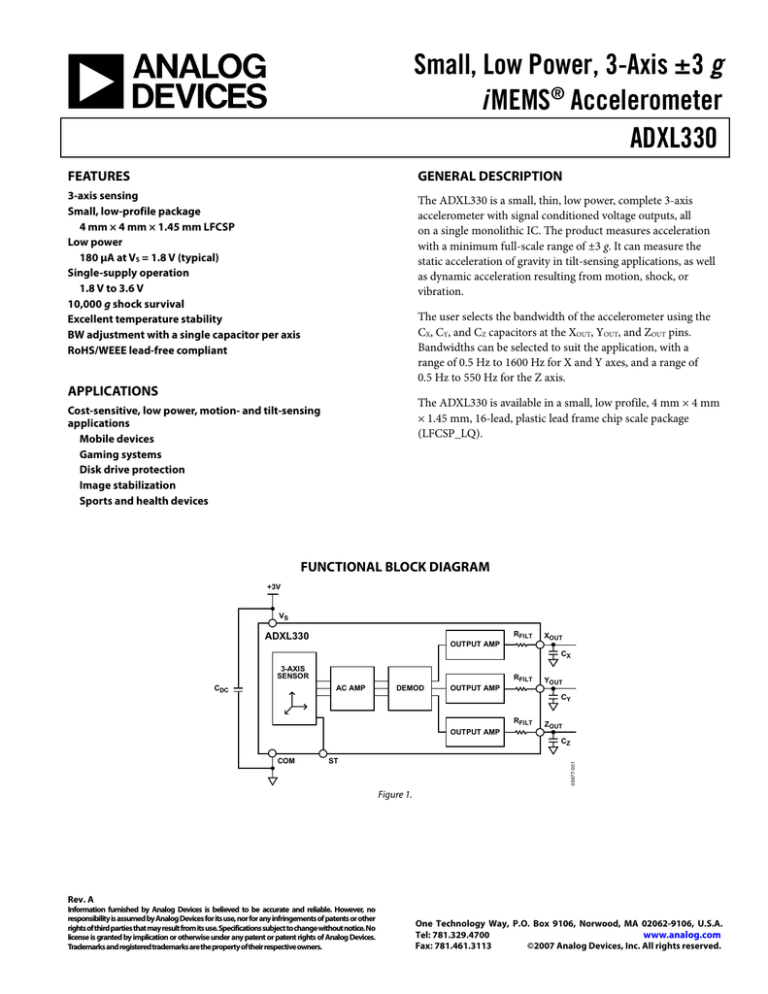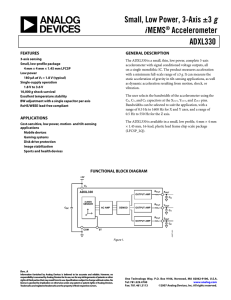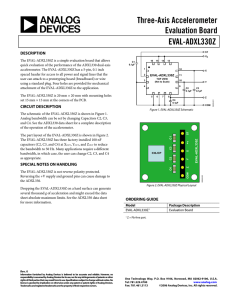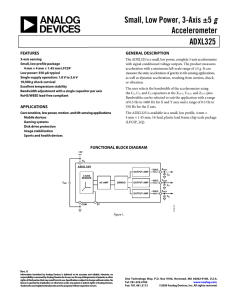
Small, Low Power, 3-Axis ±3 g
i MEMS® Accelerometer
ADXL330
FEATURES
GENERAL DESCRIPTION
3-axis sensing
Small, low-profile package
4 mm × 4 mm × 1.45 mm LFCSP
Low power
180 μA at VS = 1.8 V (typical)
Single-supply operation
1.8 V to 3.6 V
10,000 g shock survival
Excellent temperature stability
BW adjustment with a single capacitor per axis
RoHS/WEEE lead-free compliant
The ADXL330 is a small, thin, low power, complete 3-axis
accelerometer with signal conditioned voltage outputs, all
on a single monolithic IC. The product measures acceleration
with a minimum full-scale range of ±3 g. It can measure the
static acceleration of gravity in tilt-sensing applications, as well
as dynamic acceleration resulting from motion, shock, or
vibration.
The user selects the bandwidth of the accelerometer using the
CX, CY, and CZ capacitors at the XOUT, YOUT, and ZOUT pins.
Bandwidths can be selected to suit the application, with a
range of 0.5 Hz to 1600 Hz for X and Y axes, and a range of
0.5 Hz to 550 Hz for the Z axis.
APPLICATIONS
The ADXL330 is available in a small, low profile, 4 mm × 4 mm
× 1.45 mm, 16-lead, plastic lead frame chip scale package
(LFCSP_LQ).
Cost-sensitive, low power, motion- and tilt-sensing
applications
Mobile devices
Gaming systems
Disk drive protection
Image stabilization
Sports and health devices
FUNCTIONAL BLOCK DIAGRAM
+3V
VS
RFILT
ADXL330
XOUT
OUTPUT AMP
CX
3-AXIS
SENSOR
CDC
RFILT
AC AMP
DEMOD
OUTPUT AMP
YOUT
CY
RFILT
OUTPUT AMP
ZOUT
CZ
ST
05677-001
COM
Figure 1.
Rev. A
Information furnished by Analog Devices is believed to be accurate and reliable. However, no
responsibility is assumed by Analog Devices for its use, nor for any infringements of patents or other
rights of third parties that may result from its use. Specifications subject to change without notice. No
license is granted by implication or otherwise under any patent or patent rights of Analog Devices.
Trademarks and registered trademarks are the property of their respective owners.
One Technology Way, P.O. Box 9106, Norwood, MA 02062-9106, U.S.A.
Tel: 781.329.4700
www.analog.com
Fax: 781.461.3113
©2007 Analog Devices, Inc. All rights reserved.
ADXL330
SPECIFICATIONS
TA = 25°C, VS = 3 V, CX = CY = CZ = 0.1 μF, acceleration = 0 g, unless otherwise noted. All minimum and maximum specifications are
guaranteed. Typical specifications are not guaranteed.
Table 1.
Parameter
SENSOR INPUT
Measurement Range
Nonlinearity
Package Alignment Error
Interaxis Alignment Error
Cross Axis Sensitivity 1
SENSITIVITY (RATIOMETRIC) 2
Sensitivity at XOUT, YOUT, ZOUT
Sensitivity Change Due to Temperature 3
ZERO g BIAS LEVEL (RATIOMETRIC)
0 g Voltage at XOUT, YOUT, ZOUT
0 g Offset vs. Temperature
NOISE PERFORMANCE
Noise Density XOUT, YOUT
Noise Density ZOUT
FREQUENCY RESPONSE 4
Bandwidth XOUT, YOUT 5
Bandwidth ZOUT5
RFILT Tolerance
Sensor Resonant Frequency
SELF TEST 6
Logic Input Low
Logic Input High
ST Actuation Current
Output Change at XOUT
Output Change at YOUT
Output Change at ZOUT
OUTPUT AMPLIFIER
Output Swing Low
Output Swing High
POWER SUPPLY
Operating Voltage Range
Supply Current
Turn-On Time 7
TEMPERATURE
Operating Temperature Range
T
Conditions
Each axis
Min
Typ
±3
±3.6
±0.3
±1
±0.1
±1
270
300
±0.015
330
mV/g
%/°C
1.2
1.5
±1
1.8
V
mg/°C
% of full scale
Each axis
VS = 3 V
VS = 3 V
Each axis
VS = 3 V
Max
Unit
g
%
Degrees
Degrees
%
280
350
μg/√Hz rms
μg/√Hz rms
1600
550
32 ± 15%
5.5
Hz
Hz
kΩ
kHz
Self test 0 to 1
Self test 0 to 1
Self test 0 to 1
+0.6
+2.4
+60
−150
+150
−60
V
V
μA
mV
mV
mV
No load
No load
0.1
2.8
V
V
No external filter
No external filter
T
1.8
VS = 3 V
No external filter
−25
1
3.6
V
μA
ms
+70
°C
320
1
Defined as coupling between any two axes.
Sensitivity is essentially ratiometric to VS.
3
Defined as the output change from ambient-to-maximum temperature or ambient-to-minimum temperature.
4
Actual frequency response controlled by user-supplied external filter capacitors (CX, CY, CZ).
5
Bandwidth with external capacitors = 1/(2 × π × 32 kΩ × C). For CX, CY = 0.003 μF, bandwidth = 1.6 kHz. For CZ = 0.01 μF, bandwidth = 500 Hz. For CX, CY, CZ = 10 μF,
bandwidth = 0.5 Hz.
6
Self-test response changes cubically with VS.
7
Turn-on time is dependent on CX, CY, CZ and is approximately 160 × CX or CY or CZ + 1 ms, where CX, CY, CZ are in μF.
2
Rev. A | Page 3 of 16
ADXL330
THEORY OF OPERATION
The ADXL330 is a complete 3-axis acceleration measurement
system on a single monolithic IC. The ADXL330 has a measurement range of ±3 g minimum. It contains a polysilicon surface
micromachined sensor and signal conditioning circuitry to
implement an open-loop acceleration measurement architecture.
The output signals are analog voltages that are proportional to
acceleration. The accelerometer can measure the static acceleration of gravity in tilt sensing applications as well as dynamic
acceleration resulting from motion, shock, or vibration.
The sensor is a polysilicon surface micromachined structure
built on top of a silicon wafer. Polysilicon springs suspend the
structure over the surface of the wafer and provide a resistance
against acceleration forces. Deflection of the structure is measured using a differential capacitor that consists of independent
fixed plates and plates attached to the moving mass. The fixed
plates are driven by 180° out-of-phase square waves. Acceleration
deflects the moving mass and unbalances the differential
capacitor resulting in a sensor output whose amplitude is
proportional to acceleration. Phase-sensitive demodulation
techniques are then used to determine the magnitude and
direction of the acceleration.
The demodulator output is amplified and brought off-chip
through a 32 kΩ resistor. The user then sets the signal bandwidth of the device by adding a capacitor. This filtering improves
measurement resolution and helps prevent aliasing.
MECHANICAL SENSOR
The ADXL330 uses a single structure for sensing the X, Y, and
Z axes. As a result, the three axes sense directions are highly
orthogonal with little cross axis sensitivity. Mechanical misalignment of the sensor die to the package is the chief source
of cross axis sensitivity. Mechanical misalignment can, of
course, be calibrated out at the system level.
PERFORMANCE
Rather than using additional temperature compensation
circuitry, innovative design techniques ensure high
performance is built-in to the ADXL330. As a result, there is
neither quantization error nor nonmonotonic behavior, and
temperature hysteresis is very low (typically less than 3 mg over
the −25°C to +70°C temperature range).
Figure 14, Figure 15, and Figure 16 show the zero g output
performance of eight parts (X-, Y-, and Z-axis) soldered to a
PCB over a −25°C to +70°C temperature range.
Figure 26, Figure 27, and Figure 28 demonstrate the typical
sensitivity shift over temperature for supply voltages of 3 V. This
is typically better than ±1% over the −25°C to +70°C
temperature range.
Rev. A | Page 11 of 16
ADXL330
APPLICATIONS
POWER SUPPLY DECOUPLING
For most applications, a single 0.1 μF capacitor, CDC, placed
close to the ADXL330 supply pins adequately decouples the
accelerometer from noise on the power supply. However, in
applications where noise is present at the 50 kHz internal clock
frequency (or any harmonic thereof), additional care in power
supply bypassing is required as this noise can cause errors in
acceleration measurement. If additional decoupling is needed,
a 100 Ω (or smaller) resistor or ferrite bead can be inserted in
the supply line. Additionally, a larger bulk bypass capacitor
(1 μF or greater) can be added in parallel to CDC. Ensure that
the connection from the ADXL330 ground to the power supply
ground is low impedance because noise transmitted through
ground has a similar effect as noise transmitted through VS.
SETTING THE BANDWIDTH USING CX, CY, AND CZ
The ADXL330 has provisions for band limiting the XOUT, YOUT,
and ZOUT pins. Capacitors must be added at these pins to
implement low-pass filtering for antialiasing and noise
reduction. The equation for the 3 dB bandwidth is
F−3 dB = 1/(2π(32 kΩ) × C(X, Y, Z))
or more simply
F–3 dB = 5 μF/C(X, Y, Z)
The tolerance of the internal resistor (RFILT) typically varies as
much as ±15% of its nominal value (32 kΩ), and the bandwidth
varies accordingly. A minimum capacitance of 0.0047 μF for CX,
CY, and CZ is recommended in all cases.
Never expose the ST pin to voltages greater than VS + 0.3 V. If
this cannot be guaranteed due to the system design (for
instance, if there are multiple supply voltages), then a low VF
clamping diode between ST and VS is recommended.
DESIGN TRADE-OFFS FOR SELECTING FILTER
CHARACTERISTICS: THE NOISE/BW TRADE-OFF
The selected accelerometer bandwidth ultimately determines
the measurement resolution (smallest detectable acceleration).
Filtering can be used to lower the noise floor to improve the
resolution of the accelerometer. Resolution is dependent on the
analog filter bandwidth at XOUT, YOUT, and ZOUT.
The output of the ADXL330 has a typical bandwidth of greater
than 500 Hz. The user must filter the signal at this point to limit
aliasing errors. The analog bandwidth must be no more than
half the analog-to-digital sampling frequency to minimize
aliasing. The analog bandwidth can be further decreased to
reduce noise and improve resolution.
The ADXL330 noise has the characteristics of white Gaussian
noise, which contributes equally at all frequencies and is
described in terms of μg/√Hz (the noise is proportional to the
square root of the accelerometer bandwidth). The user should
limit bandwidth to the lowest frequency needed by the application to maximize the resolution and dynamic range of the
accelerometer.
With the single-pole, roll-off characteristic, the typical noise of
the ADXL330 is determined by
rms Noise = Noise Density × ( BW × 1.6 )
Table 5. Filter Capacitor Selection, CX, CY, and CZ
Bandwidth (Hz)
1
10
50
100
200
500
Capacitor (μF)
4.7
0.47
0.10
0.05
0.027
0.01
Often, the peak value of the noise is desired. Peak-to-peak noise
can only be estimated by statistical methods. Table 6 is useful
for estimating the probabilities of exceeding various peak
values, given the rms value.
Table 6. Estimation of Peak-to-Peak Noise
SELF TEST
The ST pin controls the self test feature. When this pin is set to
VS, an electrostatic force is exerted on the accelerometer beam.
The resulting movement of the beam allows the user to test if
the accelerometer is functional. The typical change in output is
−500 mg (corresponding to −150 mV) in the X-axis, 500 mg (or
150 mV) on the Y-axis, and −200 mg (or −60 mV) on the Z-axis.
This ST pin may be left open circuit or connected to common
(COM) in normal use.
Peak-to-Peak Value
2 × rms
4 × rms
6 × rms
8 × rms
% of Time that Noise Exceeds
Nominal Peak-to-Peak Value
32
4.6
0.27
0.006
USE WITH OPERATING VOLTAGES OTHER THAN 3 V
The ADXL330 is tested and specified at VS = 3 V; however, it
can be powered with VS as low as 1.8 V or as high as 3.6 V. Note
that some performance parameters change as the supply voltage
is varied.
Rev. A | Page 12 of 16







